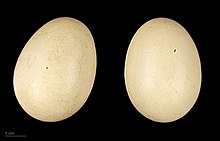Versicolorente
| Versicolorente | ||||||||||||
|---|---|---|---|---|---|---|---|---|---|---|---|---|

Versicolorente ( Spatula versicolor ) |
||||||||||||
| Systematics | ||||||||||||
|
||||||||||||
| Scientific name | ||||||||||||
| Spatula versicolor | ||||||||||||
| Vieillot , 1816 |
The versicolor duck ( Spatula versicolor ), which is sometimes also called the silver duck or the great-billed duck because of its beak color , is a species of the duck bird family . It is a small duck with a dark skull and a brownish-beige color on the face and fore neck. It is native to the southern half of South America and is also found in the Falkland Islands .
Appearance
Unlike many types of species of authentics duck is sexual dimorphism pronounced only slightly in Versicolorente. Male Versicolor ducks are slightly heavier and larger than the females, weighing an average of around 440 grams, than the females, which weigh around 370 grams on average. The height of this duck varies between 38 and 45 centimeters. Both sexes have a dark chocolate brown head plate, whereby the color contrast to the under head is a little less pronounced in the female.
The ducks have wide black and white transverse bands on the flanks of their bodies. The top of the body is pinnate golden ocher.
The chicks in their down dress already show the dark headstock. Like the top of the body and a short eye stripe, it is colored black-brown. The rest of the down garment color is a silvery white. Feet and beak are colored dark gray. Young birds are generally a little more dull in color than the adult Versicolor ducks. The top of the head is also a little more brown.
Due to the striking and characteristic head color, the Versicolor duck cannot be confused with any other duck species within its range.
Habitat and food
During their breeding season, Versicolor ducks are mostly found in shallow ponds, lakes and in marsh meadows in open grasslands. They are particularly common in the areas of the Falkland Islands that are characterized by intensive grazing and in the vicinity of Buenos Aires . Outside the breeding season, the Versicolor duck can also be observed in small flocks. It is often associated with ducks from the genus of the real ducks ( Anas ).
The feeding of the Versicolor ducks is based and being. They live mainly on seeds and green parts of aquatic and marsh plants.
Reproduction
In South America, the breeding season falls between October and November. The nests are built in the tall grass near the bank. The female incubates the seven to ten eggs for about 24 to 26 days.
Subspecies
Two subspecies are distinguished within the type of Versicolorente:
- Spatula versicolor versicolor is the nominate form and occurs in the north of the distribution area.
- Spatula versicolor fretensis is common in southern Chile, southern Argentina and the Falkland Islands. The subspecies is slightly larger than the nominate form and overall a bit darker in color.
In the past, the puna duck was classified as a subspecies of the versicolor duck. Today it is mostly viewed as an independent species.
supporting documents
literature
- T. Bartlett: Ducks and Geese - A Guide To Management . The Crowood Press, 2002, ISBN 1-85223-650-7
- Hartmut Kolbe: The world's ducks . Ulmer Verlag 1999, ISBN 3-8001-7442-1
- Hadoram Shirihai: A Complete Guide to Antarctic Wildlife - The Birds and Marine Mammals of the Antarctic Continent and Southern Ocean , Alula Press, Degerby 2002, ISBN 951-98947-0-5
Web links
- Spatula versicolor in the Red List of Threatened Species of the IUCN 2008. Posted by: BirdLife International, 2004. Retrieved on January 3 of 2009.
- Videos, photos and sound recordings on Spatula versicolor in the Internet Bird Collection


